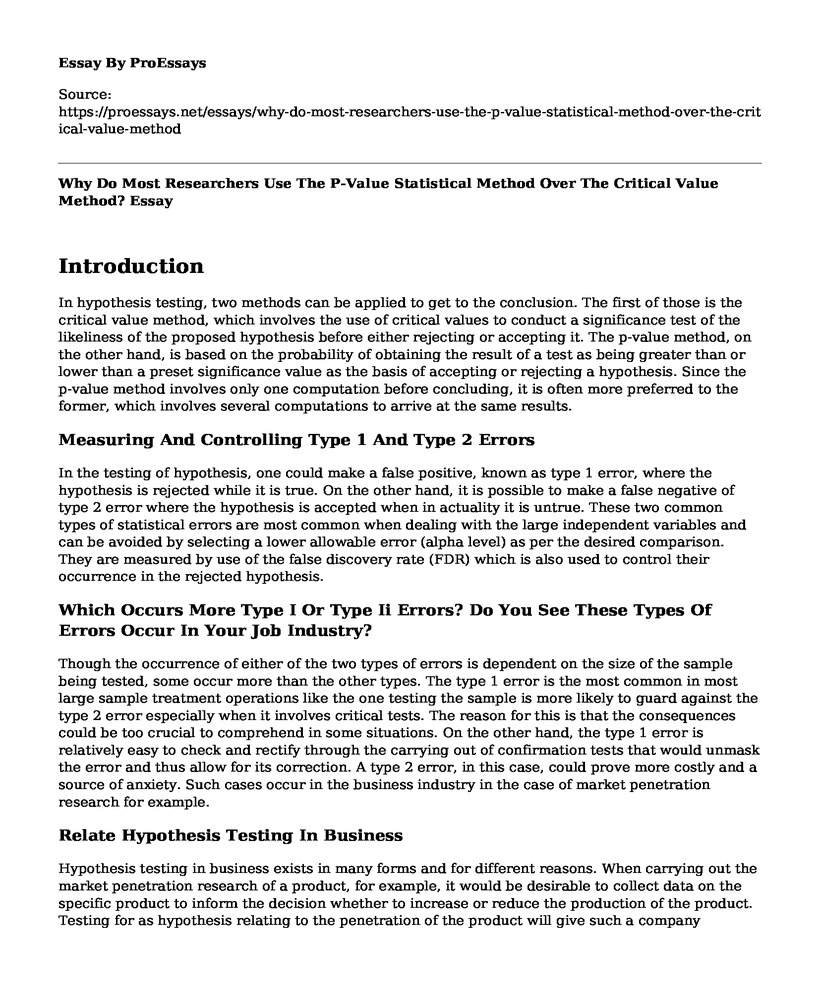Introduction
In hypothesis testing, two methods can be applied to get to the conclusion. The first of those is the critical value method, which involves the use of critical values to conduct a significance test of the likeliness of the proposed hypothesis before either rejecting or accepting it. The p-value method, on the other hand, is based on the probability of obtaining the result of a test as being greater than or lower than a preset significance value as the basis of accepting or rejecting a hypothesis. Since the p-value method involves only one computation before concluding, it is often more preferred to the former, which involves several computations to arrive at the same results.
Measuring And Controlling Type 1 And Type 2 Errors
In the testing of hypothesis, one could make a false positive, known as type 1 error, where the hypothesis is rejected while it is true. On the other hand, it is possible to make a false negative of type 2 error where the hypothesis is accepted when in actuality it is untrue. These two common types of statistical errors are most common when dealing with the large independent variables and can be avoided by selecting a lower allowable error (alpha level) as per the desired comparison. They are measured by use of the false discovery rate (FDR) which is also used to control their occurrence in the rejected hypothesis.
Which Occurs More Type I Or Type Ii Errors? Do You See These Types Of Errors Occur In Your Job Industry?
Though the occurrence of either of the two types of errors is dependent on the size of the sample being tested, some occur more than the other types. The type 1 error is the most common in most large sample treatment operations like the one testing the sample is more likely to guard against the type 2 error especially when it involves critical tests. The reason for this is that the consequences could be too crucial to comprehend in some situations. On the other hand, the type 1 error is relatively easy to check and rectify through the carrying out of confirmation tests that would unmask the error and thus allow for its correction. A type 2 error, in this case, could prove more costly and a source of anxiety. Such cases occur in the business industry in the case of market penetration research for example.
Relate Hypothesis Testing In Business
Hypothesis testing in business exists in many forms and for different reasons. When carrying out the market penetration research of a product, for example, it would be desirable to collect data on the specific product to inform the decision whether to increase or reduce the production of the product. Testing for as hypothesis relating to the penetration of the product will give such a company valuable information that they may use to base their decision on.
Concluding Post
It is true that statistics is a method used to aid in decision making and cast away perceived untested claims or assumptions. Even though the term statistics might sound like something complicate that is done only in laboratories and other sophisticated settings, the truth is that it is practiced very commonly even without knowing that we are. The truth is that statistics are present in virtually every setting and influence decisions we make in everyday life even without knowing that they are.
Cite this page
Why Do Most Researchers Use The P-Value Statistical Method Over The Critical Value Method?. (2022, Aug 23). Retrieved from https://proessays.net/essays/why-do-most-researchers-use-the-p-value-statistical-method-over-the-critical-value-method
If you are the original author of this essay and no longer wish to have it published on the ProEssays website, please click below to request its removal:
- STATDISK Program Lab Report
- Business Essay Example: Gold Gyms Overview and SWOT Analysis
- Compare and Contrast Essay on Sainsbury J Plc and Tesco Plc
- Dunkin' Donuts Analysis Paper Example
- Paper Example on SWOT Analysis: McKinsey & Co. Assesses Strengths, Weaknesses, Opportunities & Threats
- Case Study Research: Forming Questions to Map the Research - Essay Sample
- Essay Example on Policy Measures to Protect Working-Class Group from Tuberculosis







